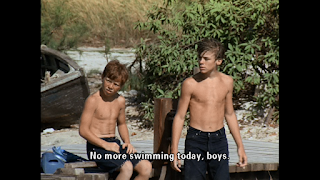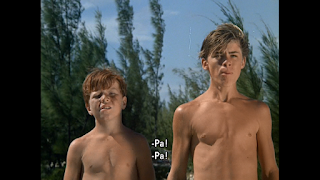Sunday, March 27, 2022
Sandy Ricks in Gulf Between (10/10/1964)
Korak in Daily Tarzan (9/20/1971-9/25/1971)
 |
| Korak in Daily Tarzan (9/20/1971) |
 |
| Korak in Daily Tarzan (9/21/1971) |
 |
| Korak in Daily Tarzan (9/22/1971) |
 |
| Korak in Daily Tarzan (9/23/1971) |
 |
| Korak in Daily Tarzan (9/24/1971) |
 |
| Korak in Daily Tarzan (9/25/1971) |
Previous blog: Korak in Daily Tarzan (9/13/1971-9/18/1971)
Robin in Ice Spy (3/29/1967) & Duo Defy (3/30/1967)
As played by Burt Ward, Robin has a cute, boyish face, clean-cut, brown hair, and a compact, athletic physique which fits perfectly with his character's acrobatic background. His colorful outfit, with his dark green mask, gloves, and booties, his bright, red shirt, his shiny, yellow cape, his tight, green panties, and his form-fitting, flesh-color leggings, certainly catches the audience's attention.
Due to his youth, inexperience, and smaller size, the Boy Wonder is clearly the weak link in the Dynamic Duo, which their opponents often seek to exploit. Robin is also cocky, enthusiastic, and overly eager to prove his independent crime-fighting abilities, especially to Batman. He is often in trouble and in need of rescue.
This week's villain is Mr. Freeze.
In the first episode, Robin is overpowered and thrown into the Sub-Zero Temperature Vaporizing Cabinet, where the sidekick is soon joined by the Caped Crusader. Mr. Freeze then intends to freeze the Dynamic Duo on place them under the ice in the rink above them.
In the next episode, the Dynamic Duo apparently locate an emergency exit which they utilize after the cabinet's glass windows frosted.
Favorite shots:
In the first episode, during the climactic fight, Robin gets into trouble twice.
First, the Boy Wonder is knocked to the ground, and a bunch of Mr. Freeze's henchmen stand over him, taking turns punching the downed Robin. Batman notices his sidekick's distress, grabs the boy's ankles, pulls the Boy Wonder away from the henchmen's punches, and helps Robin to his feet to continue to fight and get into trouble again.
Next, the Boy Wonder is knocked senseless and into the arms of one of Mr. Freeze's henchmen. This time, they lift Robin into the air, carry him, and toss him into the Sub-Zero Temperature Vaporizing Cabinet, where the sidekick is soon joined by the Caped Crusader.
Sunday, March 20, 2022
Sandy Ricks in S.O.S. Dolphin (10/3/1964)
Korak in Daily Tarzan (9/13/1971-9/18/1971)
 |
| Korak in Daily Tarzan (9/13/1971) |
 |
| Korak in Daily Tarzan (9/14/1971) |
 |
| Korak in Daily Tarzan (9/15/1971) |
 |
| Korak in Daily Tarzan (9/16/1971) |
 |
| Korak in Daily Tarzan (9/17/1971) |
 |
| Korak in Daily Tarzan (9/18/1971) |
Favorite scene: 9/18/1971, panel a
Previous blog: Korak in Daily Tarzan (9/6/1971-9/11/1971)








































